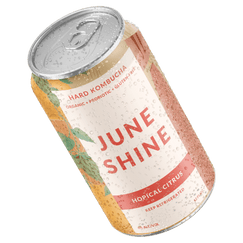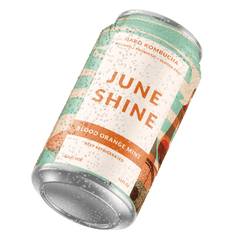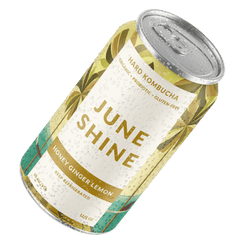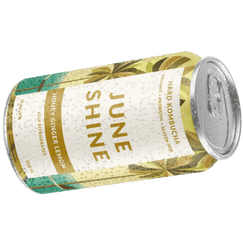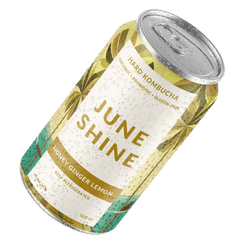Everything Blood Orange: What They Are and All You Need to Know

The blood orange. Such an evil name for such a sweet fruit.
We decided to do some digging and learn all we could about this famous fruit before adding it into our Blood Orange Mint booch.
So, get comfy and crack open a can of hard kombucha while we take a deep dive into the world of blood oranges.
Where Did the Blood Orange Come From?
The origins of blood oranges are a bit murky, but it’s agreed that they originated from Sicily. With their superior knowledge of citrus fruits, the Arabs taught the Sicilians to perfect their irrigation techniques while occupying the country between the 11th and 12th centuries. Five hundred years later, the Sicilian monks planted sweeter varieties of oranges.
In 1646, a Jesuit botanist named G.B. Ferrari studied the orangeries of the great Roman families. He published his book and reported on oranges with deep red flesh and sweet, grape-like flavor.
From 1818-1822, a Sicilian artist depicted the citrus fruits of the Mediterranean region, and blood oranges were captured for the first time. Near the turn of the 20th century, Sicilians saw the value in their blood oranges and started to export them. In the beginning, they were only for royalty and the uber-wealthy, but that didn’t last. These oranges were too good not to share.
To this day, blood oranges constitute more than three-quarters of the citrus crops in Sicily. The fruit appears in almost every Mediterranean country, including Italy, Spain, and Malta. Stateside, California, Arizona, Texas, and Florida all grow blood oranges due to their Mediterranean-like climates.
How Blood Oranges Came to California
While oranges had been growing in California since 1769, the arrival of the blood orange was a shock to many. In the 1980s, a resident of Moorpark, California, noticed the oranges on her Valencia orange tree looked different from the rest.
The resident, Mrs. Smith, was caught by surprise when she cut open the orange and saw its blood-colored interior. Used to her regular oranges, Mrs. Smith suspected foul play. She accused her neighbor of injecting blood or some kind of poison into her fruits.
In true upset neighbor fashion, she called the police, who arrived and were just as flummoxed as she was. The police brought the orange to the University of California at Riverside’s Citrus Variety Collection seeking answers to the mysterious blood-colored orange.
The scientists in residence at the college determined that Mrs. Smith’s orange tree had somehow recapitulated the birth of the blood orange. Essentially, her tree developed a mutation that happened a thousand years earlier to create the first blood orange.
We love the tart yet soothing taste so much that we added them to our hard booch for the perfect refreshing sip. If we were Mrs. Smith, we would be shaking our neighbor’s hand right now and sharing a can.
Different Shades of Orange
There are three different varieties of blood oranges on the market. They’re not always labeled when you’re shopping for them, but it’s worth knowing your options if you’re planning on cooking with them.
Moro Blood Oranges
The first variety is the Moro blood orange. These are the most common blood oranges found in the United States. The trees of the Moro orange are moderately sized, and so are their fruit. Their peel has a more maroon tint than navel oranges, and its flesh is the most intensely colored of the blood orange family, sometimes almost a shade of purple.
The Moro is the earliest blood orange to ripen and turns sour if left on the tree too long. Their flavor can be bitter if stored too long, so enjoy them only when they are in season.
Tarocco Blood Oranges
The second variety of blood orange is the Tarocco. The favored variety of Italy, this seedling line has high fruit production, large size, and deep color in its skin and rind. It has few to no seeds and the sweetest flavor of the blood oranges, with strawberry notes and high acidity. It has a wider variety of colors in its flesh, from deep red to reddish-orange, while the rind might have a red blush tint.
Tarocco trees aren’t as productive as the Moro blood orange, but they have a similar season of growth.
Sanguinello Blood Oranges
The third variety of blood orange is Sanguinello. This blood orange comes out of Spain and grows on a small to medium tree. The Sanguinello blood orange has a yellow-orange peel, often with red blushes or spots. It tends to have burgundy streaks on its flesh, and its intense pigmentation makes it the most attractive of the blood oranges.
It has few seeds and low acid content. It ripens late in the season and has a juicy, sweet flavor akin to strawberries or pineapple.
Anthocyanin, A.K.A. Red Stuff
Anthocyanin is the pigment that gives blood oranges their blood-red color. They are a type of flavonoid with antioxidant effects. Blood oranges aren’t the only fruit with anthocyanin—strawberries, grapes, and acai berries all have them as well.
The main benefit of anthocyanins is their ability to act as antioxidants and fight free radicals in the body. They develop in blood oranges thanks to warm days with cool nights during cultivation, thanks to those Mediterranean climates.
How Do Blood Oranges Compare to Regular Oranges?
Regular oranges and blood oranges both offer sweet flavors with similar nutritional content. Almost any recipe that calls for blood oranges can be made with regular oranges. It just might lack the vibrant color and a certain uniqueness.
The main difference between blood and navel oranges is—you guessed it—the color. The lack of red pigmentation in navel oranges means they are devoid of anthocyanins, although standard and navel oranges tend to have more vitamin C.
The two also have different growing seasons. Navel oranges grow and can be eaten year-round. Blood oranges harvest season is much shorter, and they are only available in the winter and early spring.
Navel and blood oranges have slightly different tastes. Oranges are known for their zest and sweet flavor. Blood oranges are more on the bitter side with a complex, tart flavor and a hint of raspberry.
What’s in a Blood Orange?
Blood oranges, like most fruits, have many health benefits. The high amount of vitamin C helps support healing processes in the body and helps improve iron absorption. Vitamin C also serves your immune system by keeping white blood cells working efficiently.
A single medium blood orange contains 70 calories, one gram of protein and fat, 15 carbohydrates, three grams of fiber, and 12 grams of sugar.
The dietary fiber content in blood oranges comes from soluble and insoluble fiber. These aid the digestive system with the insoluble fiber working as a probiotic.
Finding and Storing Blood Oranges
If you are looking to get your hands on some blood oranges, head to your local farmer’s market if you live in one of the states that grow them. You can also find them at specialty grocery stores across the country during their harvest season from December to April.
Blood oranges are generally sold individually, but expect to pay a bit more for this rare treat. As with all citrus fruits, look for a blood orange that feels heavy. This is a sign that it is full of juice and ready to be enjoyed. Choose fruits with darker skins to find darker flesh inside.
Blood oranges have thick peels, allowing for a longer shelf life than other fruits. If stored at room temperature on the counter or in a bowl, whole blood oranges will last for about a week. Once you crack open the peel, store them in a sealed container.
If you want to extend the life of blood oranges, opt for cold storage. Storing blood oranges in the crisper drawer of your refrigerator will add a couple of weeks to their shelf life.
If the peel gets wrinkled or baggy, it’s time to toss. You can store blood oranges in the freezer for a year. To do this, peel them, slice into quarters, and place them in an airtight container. To thaw, leave them on a plate in the fridge the night before you want to use them.
If you’re working with blood orange juice, you can freeze it by pouring it into ice cube trays and placing them in an airtight container.
Tasting the Tartness
Like navels, tangerines, and other citrus fruits, blood oranges have many uses in the kitchen. First, you can enjoy them on their own by using your thumb to puncture the skin. Pull back the layer of pith until the rind is removed. You may need to remove the pith using a citrus peeler, as it is thicker than other oranges. Cut the top and bottom with a sharp knife and pull apart the sections to enjoy.
In Sicily, fresh blood orange juice is enjoyed with breakfast the way we enjoy orange juice here in the States. If you are feeling creative, blood oranges also make great marmalade and jams. They can be cooked into syrups along with other spices and turned into a sticky-sweet topping for a variety of desserts and sorbets.
Blood orange zest also appears in plenty of recipes, although you should always scrub off the wax on the outside with a vegetable brush before zesting. You should also be very careful not to zest the white part of the orange, as that will be bitter and without the orange flavor that you’re going for.
A popular Sicilian dish involves blood orange, fennel, and olive oil. If you lightly cook them, you can mellow their acidity, making them perfect for chutney or other sauces. Sicilians have long enjoyed blood oranges as a side to seafood, chicken, duck, and other foods—so much so that blood oranges from Italy enjoy a protected status in Europe. Basically, blood oranges are good in everything, including booch.
Hard Kombucha and Blood Oranges
When we hear the words “tart” and “zesty,” we immediately think of pairings with kombucha, which is how we knew this was the ingredient for us.
With just blood orange, mint, beet juice, green tea, and Jun Kombucha, our Blood Orange Mint is a dangerously drinkable concoction that tastes like a soothing sip of sunshine. Whether it’s a sunset session or late-night antics, crack open a can and enjoy.
Sources:
What Is a Blood Orange? | Spruceeats.com
Blood oranges: everything you need to know | ask the food geek
Blood Oranges : Article | Gourmetsleuth.com
Blood Oranges: Change You Can Believe In | npr.org
Solved: The mystery of the blood orange | eurekaalert.org
Blood Oranges: Health Benefits, Nutrients per Serving, Preparation Information, and More | WebMD

